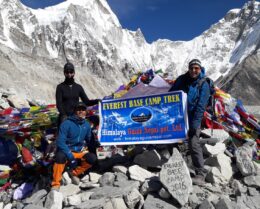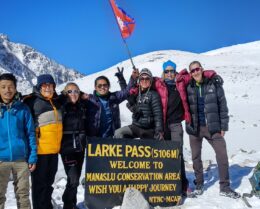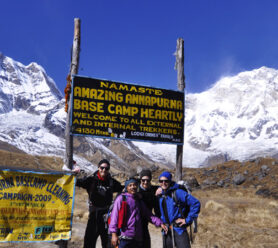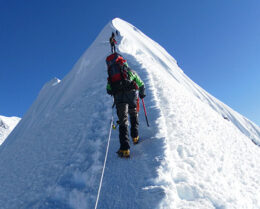Mera Peak Climbing Route
UPDATED ON 10 November, 2023
Do you want to climb to the summit of one of Nepal’s highest peaks? Mera Peak provides an impressive panoramic view of the strong Himalayas, making it a famous destination for mountaineers. So, how is the Mera Peak climbing route?
The journey starts from Kathmandu to Mera Peak and develops through numerous charming terrains and surroundings, with many ascend and descent periods. It starts with a flight to Lukla, a tough alpine village at a height of 2,846 meters/ 9,337 ft.
Your adventure begins with a spectacular journey, taking inside the captivating majesty of the Himalayas, delighting within the lush greenery of forests, and exploring the quaint cities of Chutanga, Thuli Kharka, and Thaknak. So prepare for a once-in-a-lifetime revel in.
Highlights of the Mera Peak
- Mountain peaks which include Mt. Everest, Makalu, Cho Oyu, Lhotse, and Kanchenjunga are shown in a cinematic manner.
- Beautiful sunrise and sunset views
- Investigate the Sherpa network and culture.
- Explore the flavors of neighborhood food.
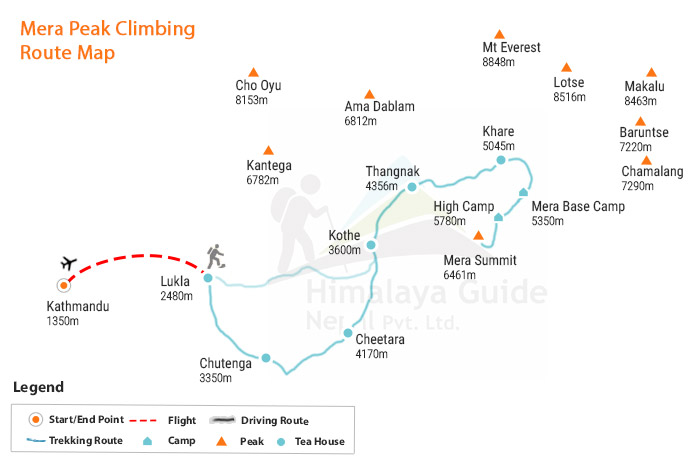
Panoramic View of Mera Peak and its Surroundings
Mera Peak, Nepal’s maximum hiking height, draws climbers from everywhere in the international area to overcome its heights within the fabled vicinity where Mt Everest looms. A spectacular Himalayan jewel in the northernmost Mahalangur variety has enticed climbers due to its accessibility.
Mera Peak gleams with three dazzling summits: Mera Central (6,476m), Mera North (6,476m), and Mera South (6,065m), all of which anticipate their conqueror. So, you’ll get stunning perspectives on the Mera Peak Climbing.
Tenzing Norway Sherpa and Sir Edmund Hillary, the pioneers of Mount Everest’s summit, initiated the addiction of ascending Mera Peak before and after Everest. Its fascination develops year after year, never dwindling. Mera Peak is an education floor for the great Everest climb.
Nepal attracts heaps of climbers every year, with Mera Peak as their final goal. Even green climbers outnumber seasoned professionals.
Mera Peak is a suitable vacation spot for beginners on their mountaineering journey, with its approachable climbing terrain and technically appropriate setup – the finest initiation to height mountain climbing.
Climbing expeditions to Mera Peak provide a variety of routes to choose from, each tailor-made for your know-how and resources. Ascend through the hard south ridge from Mera La (5,400m/ 17,717ft) or the extra forgiving direct technique from Khare (4,950m/ 16,240ft). Regardless of the path, prepare for a challenging hike through glaciers and steep inclines.
The Khumbu Valley

The Khumbu Valley, the cradle of the towering summit, weaves a fascinating path decorated with breathtaking streams and sacred monasteries peculiar to the vicinity and its citizens. The southern place includes the Tibet-bordering valley, which is encircled with the aid of the Khumbu’s towering snowfields and glaciers, with breathtaking altitudes and ice cliffs. So, you should be careful of this during the Mera Peak climbing route.
The Khumbu valley is home to a plethora of wildlife species, along with the renowned Himalayan Thar, Musk Deer, and Himalayan Tahr. Seeing one of them on a Mera Peak trip makes the experience more enjoyable and beautiful.
From the summit of Mera Peak, you can see four 8,000m peaks: Everest (8,848m), Makalu (8,643m), Cho Oyu (8,201m), and Lhotse (8,586m). The Mera Peak journey takes you through the famed Khumbu area, with its awesome Sherpa communities, luscious woods, suspension bridges, historical gompas and monasteries, prayer flags, and different highlights.
Outline Itinerary for Mera Peak Climbing
Day 1: Arrival in Kathmandu (1,400 meters / 4,593 feet)
Day 2: Kathmandu – Trek Preparation
Day 3: Fly to Lukla and trek to Paiya (Chutok) (2,730 meters / 8,956 feet)
Day 4: Paiya to Pangkongma (2,846 meters / 9,337 feet)
Day 5: Pangkongma to Ningsow (2,900 meters / 9,514 feet)
Day 6: Ningsow to Chhatra Khola (2,800 meters / 9,186 feet)
Day 7: Chhatra Khola to Kothe (3,691 meters / 12,109 feet)
Day 8: Kothe to Thagnak (4,350 meters / 14,271 feet)
Day 9: Acclimatization Day in Thagnak
Day 10: Thagnak to Khare (5,045 meters / 16,552 feet)
Day 11: Khare to Mera Base Camp (5,300 meters / 17,388 feet)
Day 12: Mera Base Camp to High Camp (5,780 meters / 18,964 feet)
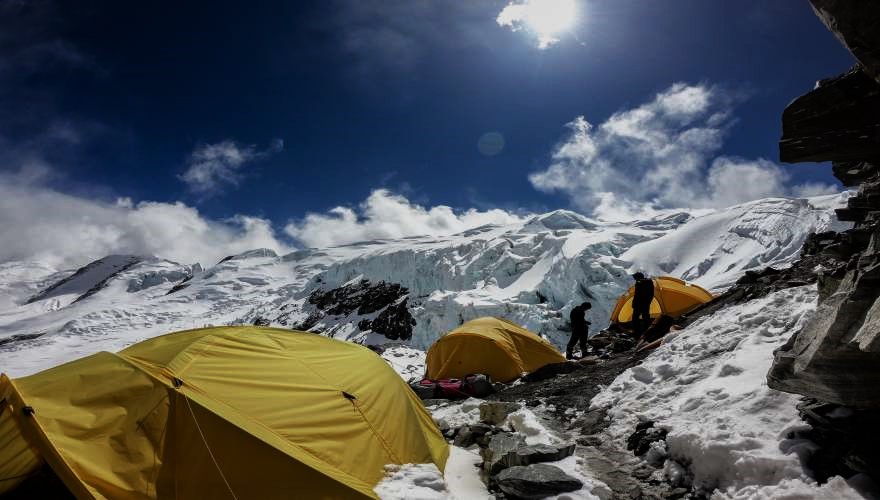
Day 13: Summit Day (6,476 meters / 21,247 feet) and Return to Khare
-Reach the summit of Mera Peak.
Day 14: Reserve Summit Day
Day 15: Khare to Kothe
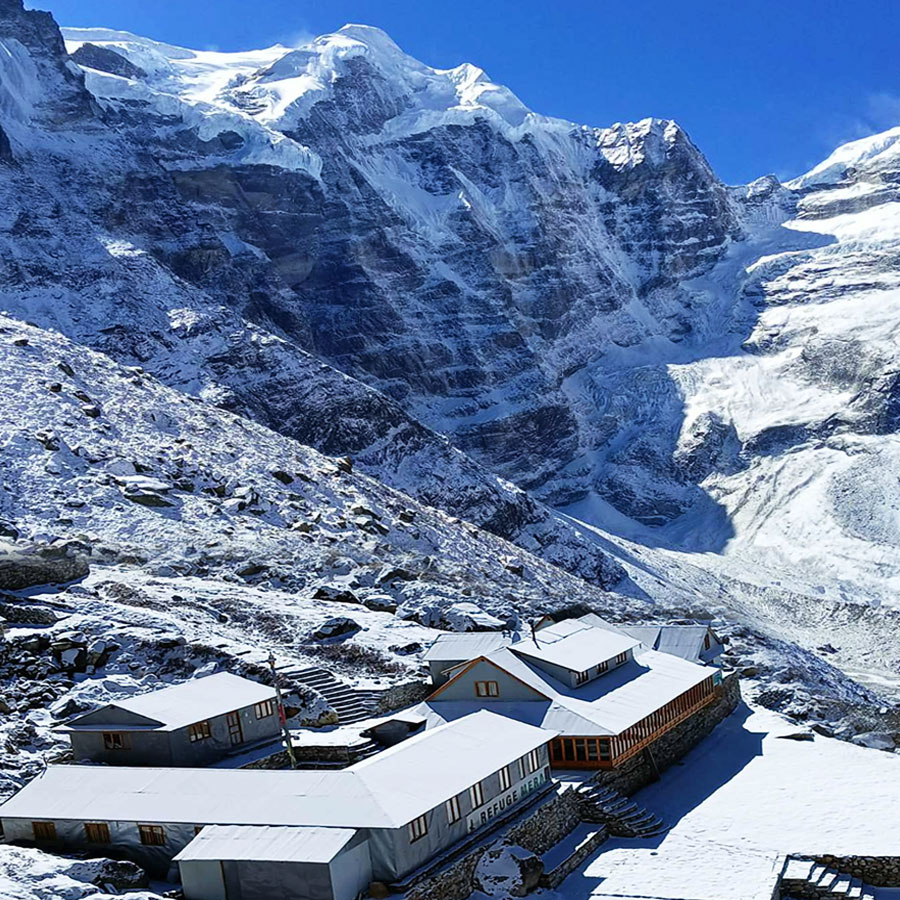
Day 16: Kothe to Thuli Kharka (4,300 meters / 14,107 feet)
Day 17: Thuli Kharka to Lukla
Day 18: Fly to Kathmandu
Day 19: Rest Day in Kathmandu
Day 20: Departure
Details of Mera Peak Climbing Route
- Various techniques to reach the summit of Mera Peak exist, but currently, the North Face is considered the best and easiest route.
- It is also the most commonly chosen direction by mountaineers when they ascend Mera Peak.
- With its passage through the excessive altitude glacier, the North Face is supposed to provide satisfactory reports. It also appeared as the safest choice because of the light snow situation.
- Your Mera Peak adventure starts in Lukla, in which you will hike to Chhuthang before departing for Thuli Kharka. During the hike, you’ll move to the Zatra Wala Pass and spend the night in Thuli Kharka.
- Early the next morning, you’ll start your trek to Thangnak. You will walk via the plush forest on a difficult trail whilst admiring the amazing herbal splendor.
- The next forestall may be Khare, which offers views of Mera Peak. You will spend the night time in Khare and acclimate the following day earlier than mountain climbing Mera Peak.
- You will ascend from Khare to Mera Base Camp (5,300 meters) and then to Mera High Camp (5,700 meters). After a difficult trek beyond the High Camp, you may attain Mera Peak (6,476 meters) and end your summit.
- To reach it, you have to descend to High Camp and Mera Base Camp. Similarly, earlier than accomplishing Lukla, you may go back to Khare, Kothe, and Thuli Kharka. You will take a flight from Lukla to Kathmandu, which will take approximately 30 to 35 Minutes.
Preparation and Safety Tips for Climbing Mera Peak
Physical Conditioning:
Mera Peak, like other peaks, is physically worrying. Before embarking on this adventure, it’s far more pleasant to have enough patience and electricity training, acclimatization, and exercise treks. Because Mera Peak is 6,476 meters in elevation, you have to be prepared for health hazards including altitude sickness and related disorders.
Preparation of the Mind:
The most essential element in hiking Mera Peak is to be mentally sturdy. Throughout your day trip, you need to acknowledge and confront any capacity hazards and the environment.
Before embarking on an adventure, thoroughly investigate the course, recognize the risks, and broaden confidence in your abilities. Therefore, you have to be careful with this in the Mera Peak mountaineering direction.
Equipment and Gear Required:
Without the appropriate equipment and devices, your Mera Peak climbing mission will fail. You must be privy to the severe environment in the Himalayas and plan your package for that reason.
It is recommended to hold thermal garb, warm jackets, and different gadgets including socks, gloves, sun shades, and plenty more. So, you should be careful of this during the Mera Peak climbing route. Aside from it, a glacier device together with an ice axe, crampons, harnesses, and protection precautions which includes a primary-useful resource kit may be required.
Acclimatization for the duration of the Mera Peak Climbing Route:
Acclimatization is essential at some point in any excessive-altitude hike. When you walk eight/nine hours a day at an excessive altitude, your frame will be exhausted and depleted of energy; that is why you need to acclimate to modify. Just be an affected person and do not rush up the mountain. Also, get lots of rest and stay hydrated.
Weather Considerations:
The weather may be a nuisance even for mountaineering. As a result, you want to constantly be privy to moving climate patterns and plan as a consequence.
Always take note of the climate prediction and put it together as a result. If the climate is bad, alternate your plans and search for alternatives. During your adventure, you’ll encounter heavy snowfall and storms.
Route Plan:
Route planning falls under the class of large planning. Always be aware of the to-be-had routes and plan your ride hence. It’s always a great concept to devise ahead of time and feature backup plans in case of a terrible climate or other unexpected situations.
Tips on Nutrition and Hydration:
Because mountain climbing Mera Peak is physically difficult, staying healthy and hydrated is important. You should be aware that your frame ought to be sturdy sufficient to address the climb, which is most effectively viable in case you are furnished with adequate vitamins and energy.
Stay hydrated and eat often to preserve strength levels; it’ll gain your fitness whilst ascending Mera Peak.
Altitude Sickness in Emergencies:
Altitude illness is one of the maximum critical fitness dangers you’ll face for your high-altitude tours. Because Mera Peak is sort of 6,000 meters excessive, altitude illness isn’t always uncommon.
Altitude illness is much more likely if you have never been exposed to high elevations before or if you have other conditions such as asthma or breathing problems.
Always keep an eye out for signs and symptoms of altitude sickness and be ready to descend if necessary. So, you ought to be careful of this on the Mera Peak climbing route.
The most vital issue to not forget is to always carry an oxygen cylinder with you because air and oxygen stages at excessive altitudes are low and may cause altitude sickness.
Injury: So, you should be careful of this during the Mera Peak climbing route.
Injuries are also a few of the maximum universal problems you will experience throughout top mountaineering. Mera Peak also has some risky terrain due to its steepness and numerous crevasses. Because you in no way recognize what is going to manifest in the course of the excursion, always have a first aid package with you in case of injury.
Conclusion
The Mera Peak path is frequently difficult but profitable for mountain climbers. If you need to witness the stunning perspectives of the Himalayas, you need to be physically healthy in addition to technically proficient. Although the climb may be hard, it affords an opportunity to learn about the particular subculture and beautiful beauty of Nepal’s Khumbu place.
You can also reach the height of Mera Peak and return home feeling successful and with a lifelong reminiscence if you plan beforehand of time, prepare efficiently, and observe capable guides.
FAQs
Where is Mera Peak Situated?
Mera Peak is a mountain Situated in the Solu-Khumbu (Everest) region of Nepal, It is one of the most popular trekking peaks in Nepal and stands at an elevation of 6,476 meters (21,247 feet) above sea level.
How long Does it Take to complete the Mera Peak Climbing Route?
The time to complete the Mera Peak climbing route can vary depending on several factors, including your chosen itinerary, and weather conditions. Typically, a standard Mera Peak climb takes about 15 to 20 days.
What is the best time to Climb Mera Peak?
The Best Time to Climb Mera Peak is two main seasons in the Himalayas such as the pre-monsoon (spring) season and the post-monsoon (autumn) season.
What are the emergency procedures in case of accidents or health issues?
In the event of accidents or health issues during a Mera Peak climbing expedition, about emergency procedures. Here are the key steps: Assess the Situation, contact Your guide or support team, First Aid, evacuation decision, stay, calm and follow instructions, communication, altitude sickness, safety, and equipment
You May Be Interested In:

